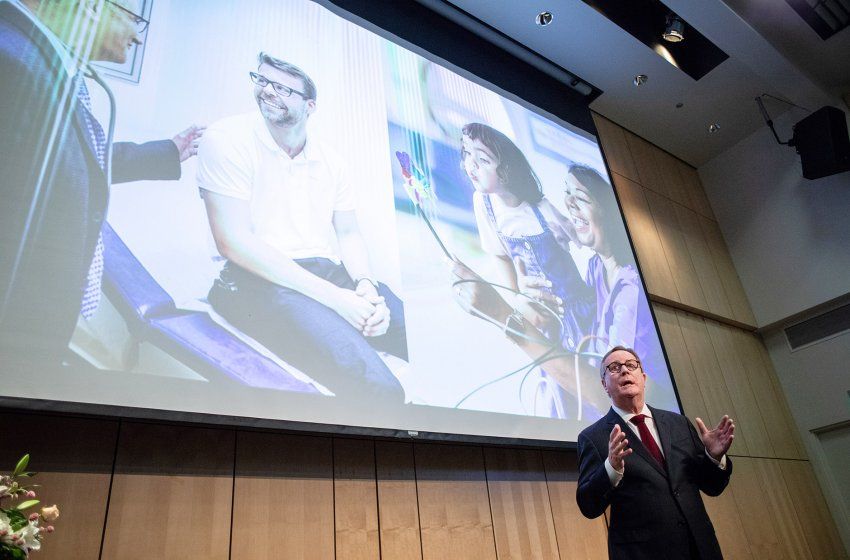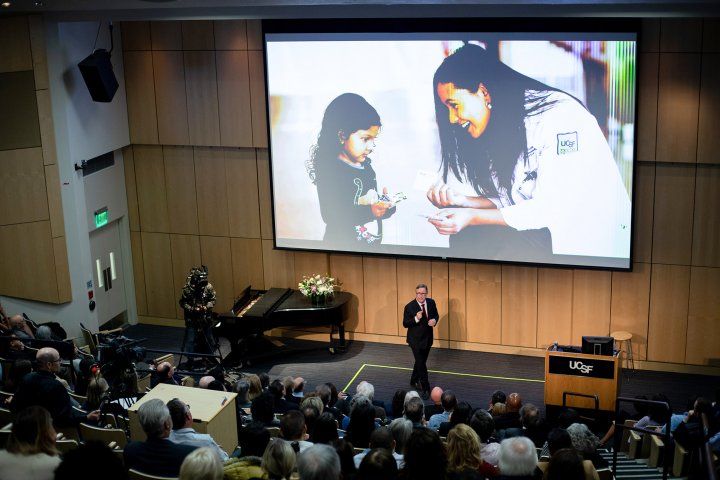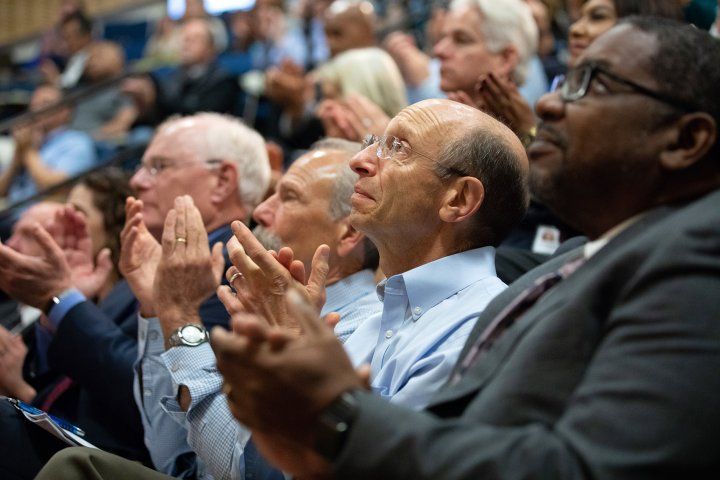Chancellor Announces Four Goals for UCSF’s Future in 2019 State of the University Address

UCSF Chancellor Sam Hawgood, MBBS, delivers his annual State of the University address to a crowd in Cole Hall on the Parnassus Heights campus. Photo by Susan Merrell
UC San Francisco is poised at a unique time and place to make dramatic advances in biomedicine, Chancellor Sam Hawgood said Tuesday during his 2019 State of the University address in which he unveiled four new goals that would help UCSF seize on unprecedented opportunities.
In a speech titled “Here and Now,” Hawgood, MBBS, recapped his five years of leading the University and reflected on its unique opportunities in the Bay Area during an unprecedented time of accelerated discovery in science and technology.
As an analogy of where UCSF is in terms of scientific discovery, Hawgood drew from biologist Stephen Jay Gould’s theory of punctuated equilibrium – which states that there are dramatic, swift jumps in evolution.
UCSF is fortunate to be located in the Bay Area, a region that has spawned some of the most innovative technology and biotechnology companies in the world, as well as four major research universities and two national labs. “The amazing ecosystem that surrounds UCSF allows us to amplify our own talent and technical capabilities,” he told the capacity crowd in Cole Hall at the Parnassus Heights campus.
The pace of scientific discovery has been unprecedented.
Hawgood pointed out that the structure of DNA was elucidated the year he was born; commercial gene engineering launched when he graduated medical school; the first human genome was published when he was promoted as a tenured professor; and that CRISPR was shown to work in human cells the year he was appointed chancellor.
“I firmly believe that before I retire, I will see our UCSF faculty cure at least one debilitating disease using genetically engineered cells or other forms of gene therapy,” he said. “Obviously, I can’t predict the particular breakthrough, but I know it will happen here and happen because of our faculty.”
Goals for Future Success
The chancellor said this intersection of circumstances, UCSF’s “here and now,” is full of promise for future growth and informed his four goals of innovation, partnerships, financial resiliency and nurturing the culture at UCSF.
Innovation
The first goal, innovation, is not new at UCSF, said Hawgood, pointing to UCSF’s history at the forefront of the biotech industry, treating the AIDS epidemic in the 1980s, reorganizing graduate education programs and developing clinical innovations, such as the hospitalist movement.
“To remain at the forefront of our missions and to continue to be an inspiration for the nation, we must not rest on our laurels. We must always be looking for emerging forces of disruption – what I like to call future scanning,” he said.
He highlighted three potential future disruptors on the horizon.
First, digital innovations, such as the new Digital Patient Experience Project and artificial intelligence for clinical image analysis, will improve health care. “Our aim is nothing short of making UCSF Health the premier digitally enabled university and health system in the world.”
Second, using cells to treat disease has the potential to be a “third pillar” of medicine along with small molecule and protein drugs. “UCSF is poised to take a leadership role in this emerging field of what I call living therapeutics. Just this year alone our faculty have published several groundbreaking advances in synthetic biology and cell engineering that provide exciting windows into the future,” he said.
Third, as technological advances supplant a wide range of human tasks, UCSF will need to respond with innovations in training staff to adapt and succeed. Additionally, the University can harness its strengths in cognitive neuroscience to innovate new ways to teach in the digital age.
Partnerships
Hawgood said there are opportunities to solidify and expand transformative partnerships across UCSF’s mission areas, but the partnerships should be chosen and managed with care.
“One thing I've learned over the last five years is that partnerships are hard to create and they're even harder to maintain,” he said. “So to be worth the effort they have to create additional value for the University and for the people that we serve. Partnerships should either strengthen our core mission or create opportunities that would be difficult or impossible to do alone.”
As an example of how partnerships can further the University’s work, the chancellor highlighted UCSF’s work toward becoming an Anchor Institution, exploring how to leverage its resources as a $7.5 billion enterprise and a major Bay Area employer to improve the well-being of our community.
“The goal is to broaden our impact as an economic catalyst and increase our ability to mitigate and counter the region’s growing inequalities,” he said.
Since last year, when the chancellor’s State of the University address focused on the work UCSF is doing in the community, the University has received a gift from Marc and Lynne Benioff that will allow Margot Kushel, MD, and her colleagues in the Center for Vulnerable Populations at Zuckerberg San Francisco General Hospital and Trauma Center to greatly expand their work studying the root causes and consequences of homelessness.
In addition, Hawgood noted that last month Matthew State, MD, PhD, chair of the Department of Psychiatry, joined San Francisco Mayor London Breed in releasing a report commissioned by UCSF and the Tipping Point Community that addresses the needs and opportunities for the most vulnerable of the homeless population – those with behavioral health, mental health or substance abuse problems.
“I'm proud of all our faculty, staff, and students who make social justice in our own community a priority,” Hawgood said.
Financial Resiliency
To make all of the goals possible, UCSF needs to remain financially strong and resilient, especially as forecasts suggest changes in the economic outlook. The University’s Ten-Year Business and Financial Plan projects solid, sustainable growth through 2029. However, Hawgood said, maintaining fiscal health will require discipline in controlling expenses and a willingness to be proactive.

The crowd in Cole Hall at the Parnassus Heights campus listens as Chancellor Sam Hawgood delivers his 2019 State of the University address. Photo by Susan Merrell
“In order to achieve our growth projection and maintain fiscal health, we will need to make sure that our costs do not outpace our revenue,” he said.
To do so, the University has started pilot projects for the campus that build upon UCSF Health’s great progress in using Lean management and operating tools. Further expansion of that work across campus will be a goal for the next five years.
UCSF also will need to build on the success of UCSF: The Campaign, which has received gifts from nearly 113,000 donors to date, of which 70,000 are first-time donors to UCSF. “Stewarding these supporters, growing our base, and getting even better in telling the story of UCSF are critical goals for building resiliency over the next five years,” said Hawgood.
People and Culture
Each of the four professional schools and UCSF Health have five-year strategic plans – all of which are key to UCSF’s future – “but these strategies will only succeed if the people working on them are fully engaged and empowered and our culture remains strong,” the chancellor said.
To ensure that UCSF is supporting everyone – regardless of role or background – he said UCSF must continue to foster diversity, equity, and inclusion to ensure that all members of the community feel respected and supported to do their best.
“We are rightly proud of our culture, our very way of being here at UCSF, but any institution’s culture is fragile. This is especially true during periods of rapid growth, geographical dispersion, and national rancor,” he said.
He urged everyone to stay committed to our shared values – Professionalism, Respect, Integrity, Diversity, and Excellence – which are key to maintaining UCSF’s exceptional culture.
‘A Period of Remarkable Growth’
Since Hawgood took the helm of UCSF as its 10th chancellor in 2014, the University has seen considerable growth: “growth in the number of people who call UCSF home, growth in our budget, growth in our facilities, but most importantly, growth in our impact.”

From left, Mark Laret, UCSF Health president and chief executive officer; B. Joseph Guglielmo, dean of the School of Pharmacy; Executive Vice Chancellor and Provost Daniel Lowenstein; and School of Medicine Dean Talmadge E. King, Jr. were among the audience for the 2019 State of the University address. Photo by Susan Merrell
UCSF’s population of faculty, staff, and learners has grown nearly 25 percent over the past five years to more than 36,000. And to support the growing health needs of the region, UCSF Health has expanded through partnerships into a robust health care system throughout the greater Bay Area.
“With these partnerships we are able to serve many, many more patients than we did just five years ago,” Hawgood said. “With these partnerships, our clinical services are also now better aligned across the care continuum, giving us the capability to take care of entire populations.”
Looking forward, UCSF’s growth in patient care will include:
- The opening of the Weill Neuroscience Building, the Valley Vision Neuroscience Building, and the Pritzker Psychiatry Building at Mission Bay next year
- New hospital facilities at Parnassus Heights and Oakland campuses
- Expanded patient care at UCSF Dental Center at Parnassus Heights
- Integrating dental and oral health more fully into UCSF Health
Turning to research, Hawgood noted that the University continues to rank as the No. 1 public university in funding from the National Institutes of Health. That achievement has drawn strength from building new programs, recruiting faculty from diverse scientific backgrounds, and establishing partnerships with other academic partners and companies in our region.
These are all increasingly important as research converges across different disciplines such as computer and data science, engineering, mathematics, physics, economics, law, business, and the environmental sciences.
This convergence has led to several interdisciplinary projects and partnerships:
- Bakar Computational Health Sciences Institute
- Population Health Data Initiative, as well as partnerships with Hastings Law and Berkeley Public Health
- Biohub, a partnership with the Chan-Zuckerberg Initiative, UC Berkeley and Stanford
- ATOM, a partnership with Lawrence Livermore National Labs, the Department of Energy, the Frederick National Cancer Lab, and GlaxoSmithKline
In education, Hawgood outlined curriculum innovation across UCSF’s five professional programs – dentistry, medicine, nursing, pharmacy, and physical therapy – and the Graduate Division over the last five years. This forward-thinking approach to education has resulted in many reforms:
- New three-year PharmD curriculum
- New Doctor of Nursing Practice program
- New San Joaquin Valley Program in Medical Education at UCSF Fresno
Other initiatives during the chancellor’s tenure to support students’ wellbeing include the Brilliant Minds pillar of the University’s fundraising campaign to help reduce professional student debt through scholarships, the opening of the Student Success Center on Parnassus to bring together key student services, and the start of construction of new multi-cultural centers on both the Parnassus and Mission Bay campuses.
The University also has faced significant challenges, foremost among them the problem of growing inequality, in terms of health access and outcomes, and incomes and opportunity, Hawgood said.
For the UCSF community, the rising cost of living in the Bay Area, already 60 percent higher than the U.S. average, further exacerbates these inequalities. He said UCSF is working to chip away at these inequalities, striving for competitive local market-based salaries and benefits for all and expanding access to below-market housing and child care.
“Equally important, we are committed to expanding our initiatives to reduce unconscious bias, micro-aggressions, and address the differential experience of those who are underrepresented in our community,” Hawgood said.
Exponential Age
In closing, Hawgood returned to his evolution analogy, reflecting that the acceleration of today’s scientific advances may not merely be a “punctuation” but the emergence of an “exponential age” in which the rapid technological advances allow for no period of recovery and stabilization between punctuations.
“To me, it means two things. It means we must develop the institutional will to recognize future forces early and then embrace innovation. It also means that we must have the courage to transform our naturally cautious university, yes thoughtfully and strategically, but we must continue to position us well for the future, not for today” he said. “I am confident that UCSF will not only survive in this exponential age but will thrive and provide national leadership at this time of unprecedented opportunity.”